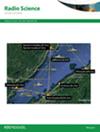一种基于cm的多目标角闪烁特征快速计算方法
IF 1.5
4区 地球科学
Q3 ASTRONOMY & ASTROPHYSICS
引用次数: 0
摘要
提出了一种基于特征模态理论的快速提取多目标角闪烁特征的新方法。利用基于efie的特征模态方程,得到了单个目标的特征模态。通过对入射平面波产生的初级电流和初级散射场的线性叠加,得到了每个物体的cm。将重建的一次电流作为二次源,也可以用线性叠加法计算物体间的耦合效应。最后,利用重建的散射场,利用能量流倾斜概念计算角闪烁线性偏差。算例验证了该方法的准确性和有效性。利用该方法对不同间距和姿态的无人机编队角闪烁进行了研究,为增强或抑制多目标角闪烁提供了有价值的参考。本文章由计算机程序翻译,如有差异,请以英文原文为准。
A CM-based fast computation method for the angular glint feature of multiple objects
A novel method based on the theory of characteristic modes to fast extract the angular glint feature of multiple objects is proposed in this paper. The Characteristic Modes (CMs) of a single object are obtained with the EFIE-based CMs equation. The primary currents induced by the incident plane wave and the primary scattering fields are obtained through the linear superposition of each object's CMs. Considering the reconstructed primary currents as secondary sources, the coupling effect among objects can also be calculated using linear superposition. Finally, the reconstructed scattering field is utilized to calculate the angular glint linear deviation with the energy-flow tilt concept. The accuracy and efficiency of the proposed method are validated by several examples. The angular glint of unmanned aerial vehicle formations with varying spacings and attitudes is studied with the proposed method, providing a valuable reference for enhancing or suppressing the angular glint of multiple objects.
求助全文
通过发布文献求助,成功后即可免费获取论文全文。
去求助
来源期刊

Radio Science
工程技术-地球化学与地球物理
CiteScore
3.30
自引率
12.50%
发文量
112
审稿时长
1 months
期刊介绍:
Radio Science (RDS) publishes original scientific contributions on radio-frequency electromagnetic-propagation and its applications. Contributions covering measurement, modelling, prediction and forecasting techniques pertinent to fields and waves - including antennas, signals and systems, the terrestrial and space environment and radio propagation problems in radio astronomy - are welcome. Contributions may address propagation through, interaction with, and remote sensing of structures, geophysical media, plasmas, and materials, as well as the application of radio frequency electromagnetic techniques to remote sensing of the Earth and other bodies in the solar system.
 求助内容:
求助内容: 应助结果提醒方式:
应助结果提醒方式:


